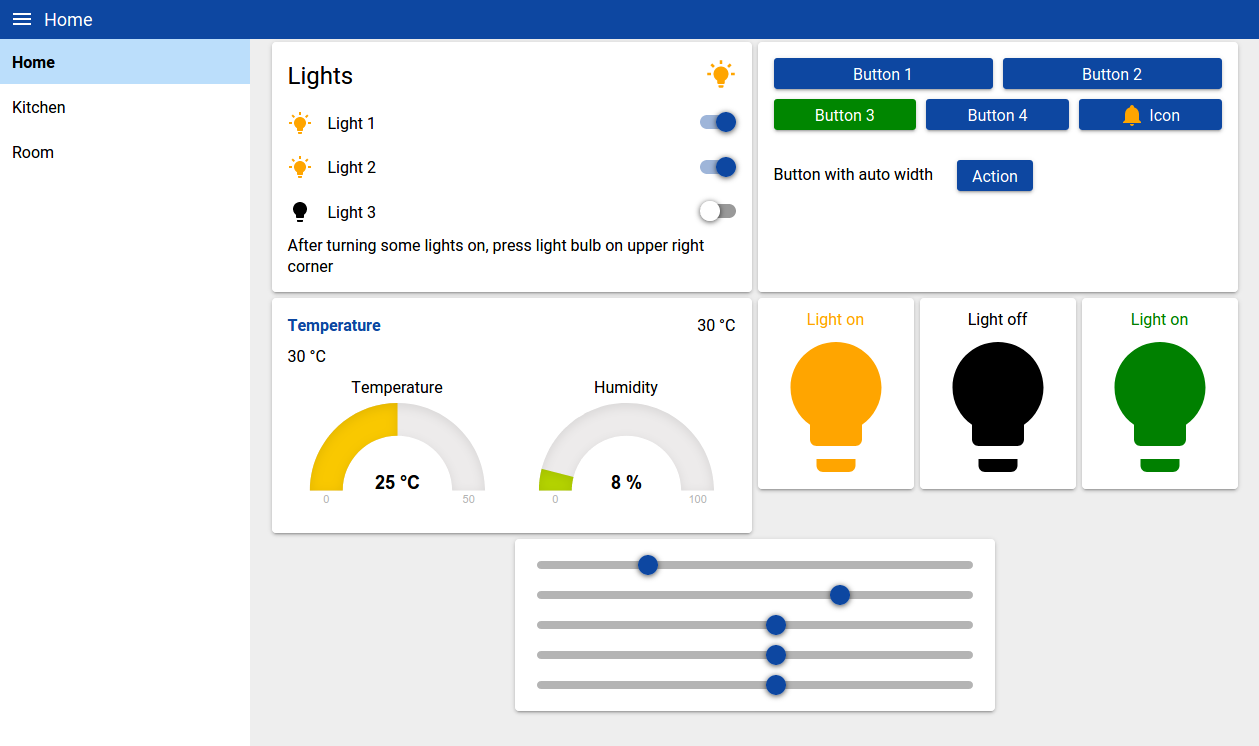A Node-RED dashboard based on web-components.
This package allows you to create dashboard widgets as web-components that are accompanied their own Node-RED node. Being a web-component, a widget becomes an HTML-tag.
Building the dashboard then means to design an HTML page, i.e. plugging together HTML-tags and styling them with CSS. The widgets automatically send and receive messages to/from Node-RED.
Most of the widgets that are provided don't have any dependencies at all. This dashboard tries to be not tied to any web framework.
Dependencies have been updated, which mainly involved updating the parcel bundler from version 1 to 2.
Unfortunately, updating to parcel version 2 implies a small breaking change.
The script tag in the index.html file has to contain type="module" now, meaning <script src="./main.js"></script> has to be replaced with <script type="module" src="./main.js"></script>.
Further, the bundle script has been changed, as the API of parcel has changed quite a bit.
It is now called bundle.mjs instead of bundle.js, to make to more apparent.
Please see also parcel.
Go to your Node-RED user folder (e.g. ~/.node-red) and run
npm install --save cinhcet/node-red-contrib-component-dashboard
The following assumes that userDir is the user directory of your Node-RED install and Node-RED can be reached at http://127.0.0.1:1880.
You can create as many independent dashboards as you want.
Each separate dashboard is represented by a configuration node, called yad-configuration, which has a single property name.
When a new yad-configuration node is created with, for example, name yad, a new folder in your Node-RED user directory will be created userDir/yad/yad. There you can find index.html, style.css, widgets.js. With these files, you create your dashboard.
Everytime a file in userDir/yad/yad is changed or the first time a new yad-configuration node has been created, you need to run
node bundle.mjs
in userDir/yad/yad.
This will invoke parcel.js to bundle your dashboard files to userDir/yad/yad/dist.
Note that it could be necessary to run node bundle.mjs twice the first time.
After bundling, the dashboard can be reached at http://127.0.0.1:1880/yad
The template that is copied automatically when a new dashboard is basically empty.
To get started, locate the node-red-contrib-component-dashboard module, most probably be found in userDir/node_modules/node-red-contrib-component-dashboard and then go to the folder node-red-contrib-component-dashboard/templates/exampleDashboard_1 where you can find an example flow flows.json you can import into Node-RED.
After deployment, copy all files (except flows.json) from node-red-contrib-component-dashboard/templates/exampleDashboard_1 to userDir/yad/yad and run the bundling (node bundle.mjs). This will give you a basic dashboard at http://127.0.0.1:1880/yad.
The best way to create your own widgets is to look at the widgets delivered with the package and to learn about web-components. If you can create your widget as a web-component, then interfacing it with Node-RED via the provided helper functions is really easy.
Writing native web-components is a good exercise and for simple widgets like a button makes a lot of sense. However, when creating more involved widgets you very quickly want to have two things: 1) a way to deal with the properties and attributes of the component (or more precisely to sync them) and 2) a template engine. Exactly these two requirements are provided by Lit, which is a really light-weight library and not a framework that helps you to reduce the boilerplate code in writing web-components and has a very nice template engine. Of course, you could also use other web-component libraries.
Feedback/discussion is appreciated. Please do not hesitate to contact me, e.g. via github issues or in the Node-RED forum!
Only modern browsers are supported. I have only tested on firefox and chrome. Feedback appreciated.
The standard dashboard for Node-RED node-red-dashboard is very convenient. You can create dashboards directly from Node-RED. However, this convenience also implies less flexibility (e.g. you have to use angularjs).
When this project started, it was also not possible to create new widgets for node-red-dashboard, which is now possible. But still, I need more flexibility in creating my dashboards, for example to integrate a music browser/player into it. Then I came across node-red-contrib-uibuilder, which is somehow the complete opposite of node-red-dashboard. It gives you a lot of freedom in developing your dashboard and helps you to establish the connection to Node-RED. However, what I personally don't like is that all the communication goes to one single Node-RED node, not like with node-red-dashboard, where every widget has its own node.
Therefore, I created this dashboard, which is called node-red-contrib-component-dashboard, or in short yad for YetAnotherDashboard. This is somehow in between node-red-dashboard and node-red-contrib-uibuilder in the sense that you have the freedom of creating your dashboard as you want, but at the same time have the convenience that every widget on the dashboard has its own node in Node-RED.
The standard way of communication between Node-RED and the dashboard widgets is via websockets. However, there is also the possibility that a widgets performs an ajax call to its backend node. Messages can be replayed automatically when a new client connects.
See above.
Version 1.0.0 had been updated significantly from earlier versions.
The main reason for this was to get rid of polymer 3, which is not developed any further.
This meant that all widgets had to be rewritten. Instead of again relying on a framework to generate the widgets, most widgets are now native web-components, meaning no dependencies at all.
There is one exception, the yad-app-drawer-layout widget is created with lit-element.
Furthermore, new widgets have been introduced, like a slider, a more advanced switch/toggle and a gauge widget.
The behavior of the new widgets is similar, but not equivalent.
If you still want to use the old polymer 3 widgets, install https://github.com/cinhcet/node-red-contrib-component-dashboard-legacy-widgets via
npm install --save cinhcet/node-red-contrib-component-dashboard-legacy-widgets
in your Node-RED user directory.
Then update the imports in widgets.js to point to those old widgets.
It is highly recommended to update to the new widgets, which should not take an unreasonable amount of time.
This dashboard was inspired by
- node-red-contrib-uibuilder from TotallyInformation
- node-red-dashboard from the Node-RED team
- node-red-contrib-polymer from hobbyquaker


